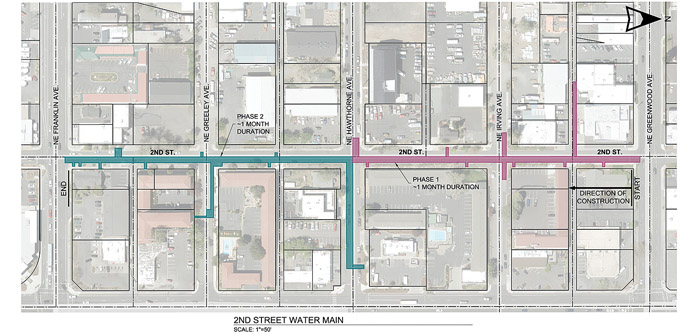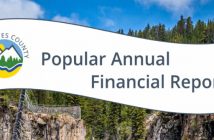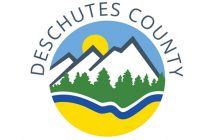(Waterline Work with Open Trench Locations | Graphic courtesy of City of Bend)
First Phase Begins Soon for Routes Across Greenwood Including $25m+ Bridge
The first phase of the City of Bend’s major Midtown Crossings plan gets underway this summer as part of a flagship infrastructure project that will provide safer travel and easier access between the Central District and downtown. This project will improve four essential routes in the Core Area: Franklin Avenue, Greenwood Avenue, Second Street and Hawthorne Avenue, with the latter to feature a bridge, over Highway 97 and the railroad, the design of which has yet to be finalized.
The landmark bridge proposal received a huge boost last year when the project was awarded $25 million in state and federal funds. The State will assist with managing the bridge project through design and construction due to federal funding requirements. The city is currently designing a variety of safer and more accessible routes throughout the community for those walking, biking or rolling (using a wheelchair or other mobility device) and investment in the core area, creating safe connections and developing a more complete transportation network is seen as a top priority.
Another aim is to reduce traffic-related accidents on Greenwood Avenue. Between 2015 and 2019, rear-end crashes made up 40 percent of accident types and turning movement crashes 24% for the same period. A left turn lane on Greenwood would decrease these statistics and make travel safer and more accessible. Design work is now underway for several of the midtown connections and streetscaping projects, with construction occurring at different times due to individual project durations, construction detours, and other agency requirements.
Greenwood is known as a busy route connecting Bend’s west side, downtown and core area, and traveling along the route for all users can be difficult. Updates to Greenwood will be completed in phases, with the first beginning this summer, featuring what’s called a “quick build” process that will see surface treatment design changes from Wall Street to Second Street to make the route safer for all users.
It is referred to as a quick build because the project involves lower cost, quicker installation surface treatments that will be evaluated for a year before deciding the full-build construction next summer, incorporating public feedback.
This project may include:
- Lane reconfiguration of the current four lanes to three lanes (one eastbound, one westbound, one turn-lane);
- Protected vehicle left-turn lanes;
- Connection to the existing bike lane on Newport Ave.;
- Protected bike facility under US 97 and the BNSF railroad bridge;
- Safety-enhanced bike and pedestrian crossings at Second St. and Harriman St.;
- Improvements to transit stops.
The origins of the ambitious plan to better connect the West and East sides of town stretch back to 2020, when the community identified the need for the Midtown Crossings project during planning for the future of Bend’s Transportation System and the Core Area. It is funded by the $12 million Transportation GO Bond approved by voters at that time. Other funding comes from The American Rescue Plan Act (ARPA), The Oregon Department of Transportation (ODOT) All Roads Transportation Safety (ARTS) Program, The Core Area Tax Increment Finance Construction Fund and 2021-2026 Capital Improvement Program funds.
Through improving connectivity and safer access, one aim is to encourage private development in the Core Area, where much of Bend’s future housing and employment growth is anticipated to take place. The Second Street Improvements will include on-street parking, bicycle “sharrows,” or shared lane markings, complete sidewalks, intersection bulb-outs, improved lighting, landscaping and stormwater improvements, with construction set to occur in fall 2024. Greenwood and Franklin Avenue corridors will feature undercrossing improvements The project will also add on-street parking, improved lighting, and landscaping, including trees and catch basins and dry wells for stormwater management.
This project will define how to make walking, biking and rolling safer and more convenient on Franklin Avenue between Harriman and Fourth Street via improvements to the pedestrian undercrossing. This will create options for how to use the street space and improve the pedestrian undercrossing, including sidewalks and bike lanes, lighting, landscaping and stormwater management, fencing or railing, painting and upgraded signs.
Second Street is seen as a low-stress route for biking and walking connecting with several other key routes in the Central District. This part of the overall project will modernize and upgrade Second from Franklin to Greenwood and feature streetscape improvements. Waterline work will also be conducted along Second below street level to replace the water main, which is at the end of its service life. The project is essential to replace cast iron pipes from the 1950-70s and prevent pipe ruptures, while the new system will also support Bend’s future growth in the Core Area.
Work will be done with open trench construction, meaning there will be a hole/trench cut in the ground, one block at a time, and most work will be on the east side of Second, with the west side of the street open for local traffic access. To upgrade water mainlines and private property connections on some side streets, the City will also need to use open trenches in those locations.
The biggest piece of the E-W connectivity masterplan is the Hawthorne Overcrossing (Hill St. to Second St.), and this project will define how best to build a bridge for walking, biking and rolling on Hawthorne Avenue from Harriman Street to Second Street, for safer passage over the parkway and railroad. It will decide the bridge type and consider how to connect with other streets. Public feedback opportunities will focus on the bridge’s structure, appearance and cost and the state will assist with managing the project through design and construction due to federal funding requirements.
A bridge alignment has been selected based on prior public feedback. A straight alignment with long approach ramps:
- Best reflects community needs and goals;
- Is more affordable than other designs;
- Prioritizes visibility and safety, with no angles or corners;
- Provides a clear, direct route for walking and biking;
- Offers views in all directions from the bridge deck;
- Meets standards for universal accessibility;
- Is more ADA accessible.
The public is invited to join an Open House on July 10, between 4:30-6:30pm at the Campfire Hotel, on NE Third Street, to help pick the bridge type and learn more. There are four options which will be narrowed down to one recommendation to give to ODOT. An online open house will be available from July 1 to 17. Design is slated to take place next year, with construction anticipated to be complete by the end of 2027.
The project has received widespread support, including from the Bend Chamber of Commerce, Central Oregon LandWatch, the Bend Central District Business Association and numerous other local, state and federal agencies and organizations. “The Midtown Crossings are vital to catalyzing redevelopment of Bend’s Central District and Core Area,” said Corie Harlan, Cities and Towns program manager of Central Oregon LandWatch. “These key areas of our city will accommodate more of Bend’s rapid growth in ways that deliver complete communities — places with more affordable housing options close to essential services, with nature nearby and convenient, safe ways to get around that don’t always require a car. This critical and transformative Hawthorne Overcrossing project will help ensure Bend is a more equitable, healthy, and climate-resilient place for all.”
“The Hawthorne Overcrossing is so much more than a transportation project,” Katy Brooks, CEO of the Bend Chamber of Commerce, added. “It is a significant step forward for economic development in the Central District and Downtown and joins two sides of the parkway that invites people to regularly travel between east and west whether that’s by walking, riding, or rolling. It will be a centerpiece in Bend.”
There will be several upcoming public open houses on the overall Midtown Crossings concept and online engagement opportunities for the public to weigh in on project considerations.




